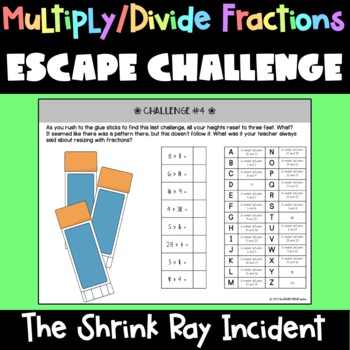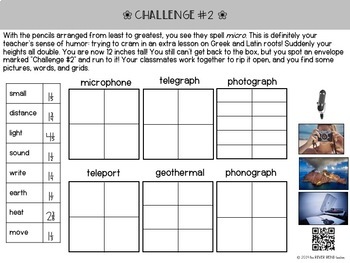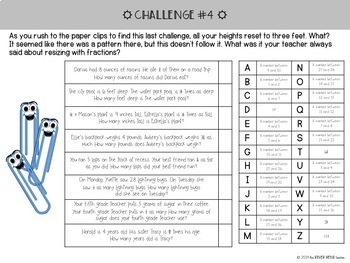Multiply & Divide Fractions Escape Challenge Game - 3 Levels!
- PDF
What educators are saying
Also included in
- Save time and money with this bundle of three fifth grade math escape challenges!This bundle includes two printable and one digital escape challenge.All three escape challenges include:Three levels of difficultyAnswer keyStandards-focused activities to align to your math unitsTimeless, inclusive thePrice $9.50Original Price $13.50Save $4.00
Description
Looking for a way to practice challenging word problems about Multiplying and Dividing Fractions? Upper elementary students LOVE escape room games! This challenge includes 3 levels of challenge for the fifth grade Number and Operations: Fractions standards that relate to multiplying and dividing fractions. This allows you to differentiate instruction effortlessly, AND allows students at all levels to be successful. It's the perfect complement to your Guided Math Workshop!
Students will push themselves to solve challenging word problems and work cooperatively to be the first team to recover from the Shrink Ray and get back to their regular size. If you group your students for Guided Math Workshop, you can easily assign different levels to different teams and give all your student an opportunity to be successful. Prep can be as easy as printing out each challenge ahead of time and handing them to students as they progress, or you can try a classroom transformation and hide the puzzles in areas of your classroom that students will find when they solve each puzzle. It's up to you -- I've done it both ways in my own classroom!
Here's what you'll get:
- Four challenge puzzles, each at three levels of difficulty
- Word problems and puzzles addressing ALL fifth grade standards related to multiplying and dividing fractions, mixed numbers and whole numbers, including multiplication as scaling.
- Labels for envelopes, if you choose to hide them
- A Google Slide template for organizing and displaying teams
- A one-page answer key to help you manage teams at working different levels and on different puzzles
- A congratulations message for the team who escapes first
- A choice of signs for the winning team to hold in photos
The word problems and puzzles in this game are much more challenging than what students are likely to see in their curriculum. I'm always amazed at how my students push themselves and each other whenever we play escape room challenge games, building on each other's ideas and solving problems together as a team to win!
I love using escape room games for:
- End-of-unit review
- Shaking up the routine
- Teambuilding
- Coming back from a break
- Standardized test prep
Because I have included three levels of difficulty, all tied to fifth grade standards, fourth and sixth grade teachers may find this activity useful for enrichment, review, or intervention. Fifth grade teachers can deploy several levels simultaneously without disrupting game play. Use the ❀ pages for students working at grade level. Use ★ pages for those who need extra support and ☼ for those who need an extra challenge. The symbols allow students to have work at their level without making it obvious to everyone. It also helps prevent groups from getting answers from each other. If you teach fifth grade, you know that these are major concerns!
The shrink ray theme is timeless -- useful no matter what time of year you teach these standards and avoids holidays or themes that would exclude certain students. This escape challenge is low-prep. All you need is a box and some envelopes along with this resource to give your students a memorable opportunity to collaborate on some challenging math!
Whether you're a shrink ray sci-fi geek or just love oversized school supplies, you and your students will love trying on sizes to multiply, divide and scale fractions, mixed numbers, and whole numbers to return to your original size.





